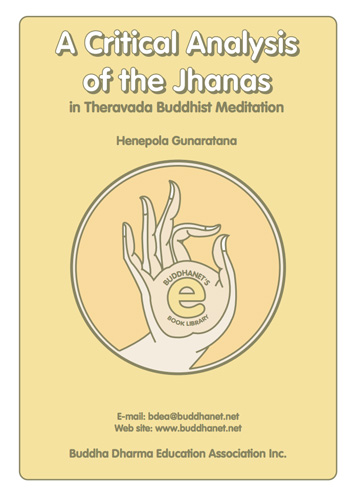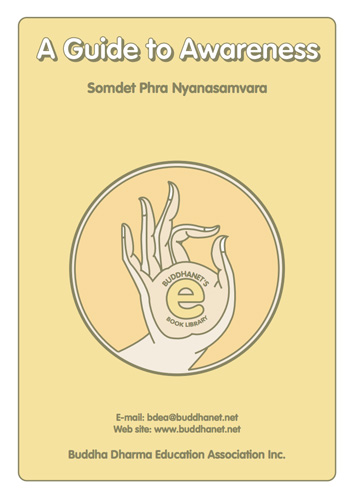 Most viewed - Buddhist Meditation Most viewed - Buddhist Meditation |

chanmed1.pdfFundamentals of Ch'an Meditation Practice6335 viewsTing Chen, Tr. Master Lok To
The Fundamentals of (Ch'an) Meditation Practice by Ting Chen. Originally, one's own mind and nature are pure, and there is nothing to accept and nothing to refuse; there is neither existence nor nonexistence; there is only clear understanding without attachment and with no dwelling. One who wants to know the no-attachment, no-dwelling mind can find it through meditation, because it is only then that the mind does not think of right and wrong, of good and evil or of self and others.
|
|

fourelements.pdfMindfulness of Breathing and the Four Elements Meditation5729 viewsVen. Pa-Auk Sayadaw
This book contains the instructions for mindfulness-of-breathing meditation, the four-elements meditation, and the subsequent detailed discernment of materiality. The last section of this book covers some of the relevant theory. Several pages have been added by the Sayadaw covering the balancing of the five controlling faculties and seven factors of enlightenment. There is also the addition of his explanation of the difference between the experience of Nibbana and the experience of life.
|
|

01Practicing_Vipassana.pdfPracticing Vipassana Meditation5389 viewsMany people all over the world are now practicing the Buddhist meditation known as Vipassana or Insight Meditation. Western psychotherapies have taken it up as ‘mindfulness’ as well as ordinary people who have found it beneficial in coping with the stresses and strains of modern life. While many are increasingly taking time out to attend retreats in Vipassana meditation centres. So this series of text will take you the basic practice.
|
|

4sublime_states.pdfThe Four Sublime States5381 viewsVen. Nyanaponika Thera
Four sublime states of mind have been taught by the Buddha: Loving-kindness (metta), Compassion (karuna), Sympathetic Joy (mudita), Equanimity (upekkha) These four attitudes are said to be excellent or sublime because they are the right or ideal way of conduct towards living beings They provide, in fact, the answer to all situations arising from social contact. They are the great removers of tension, the great peacemakers in social conflict, and the great healers of wounds suffered in the struggle of existence. They level social barriers, build harmonious communities, awaken slumbering magnanimity long forgotten, revive joy and hope long abandoned, and promote human brotherhood against the forces of egotism.
|
|

06_the_mahasi_method.pdf06 Introducing the Mahasi Method5360 viewsPatrick Kearney
This is an introduction to the method of insight meditation developed by Mahasi Sayadaw of Myanmar which sums up our introduction to serenity and insight by examining a particular approach to insight meditation.
|
|

deathless.pdfMindfulness: The Path of the Deathless5258 viewsAjahn Sumedho
The aim of this book is to provide a clear instruction in and reflection on Buddhist meditation as taught by Ajahn Sumedho, a bhikkhu (monk) of the Theravadin tradition. It has been edited from talks Ajahn Sumedho has given to meditators as a practical approach to the wisdom of Buddhism. This wisdom is otherwise known as Dhamma or 'the way things are'. It is a step-by-step manual on the practice of meditation.
|
|

02_contemplating_movement.pdf02 Contemplating Movement5235 viewsPatrick Kearney
Contemplating movement. Here we explore the nature of distraction and its relationship to the fact of change. This brings us to insight meditation, and incorporating movement into the practice. We begin walking meditation, and introduce the standing posture.
|
|

Wisdom_Develops_Samadhi.pdfWisdom Develops Samadhi5174 viewsAnapanasati Bhavana (developing the awareness of breathing) uses the breath as the objective support of the heart and consists in knowing and mindfulness (sati) of in and out breathing. In becoming aware of breathing, one should at first fix attention on the feeling of the breath at the nose or the palate (roof of the mouth), as it suits one, because this is where the breath initially makes contact, and one may use this as a marker point for holding one's attention. Having done this until one has become skilled, and the in and out breathing becomes finer and finer, one will progressively come to know and understand the nature of the contact of in and out breathing, until it seems that the breathing is located either in the middle of the chest or the solar plexus. After this one must just fix one's attention on breathing at that place and one must no longer be concerned about fixing attention on the breathing at the tip of the nose or the palate, nor about following it in and out with awareness…
|
|

scrnguna.pdfA Critical Analysis of the Jhanas in Theravada Meditation5164 viewsThis work, by Ven. Henepola Gunaratana, provides an analytical study of the Jhanas, as they are an important set of meditative attainments in the contemplative discipline of Theravada Buddhism. Despite their frequent appearance in the texts, the exact role of the Jhanas in the Buddhist path has not been settled with unanimity by Theravada scholars, who are still divided over the question as to whether they are necessary for attaining Nibbana.
|
|

gawarens.pdfA Guide to Awareness5143 viewsThe Foundations of Mindfulness (Satipatthana Sutta). This is a series of twenty-two talks given at Wat Bovornives, Bangkok by H.H.Somdet Phra Sanasamvara, Supreme Patriarch of Thailand. The Four Foundations of Mindfulness is the Buddha's explanation of the practice of mindfulness meditation within the framework of four foundations of awareness: body, feelings, mind-states and the mental content. If you read this book, you will discover the truth of the 'knots' and problems that exist within you. In short, this can be described as the 'knot of suffering'. You may also then see the method to unravel and safeguard against this suffering.
|
|
|
|
